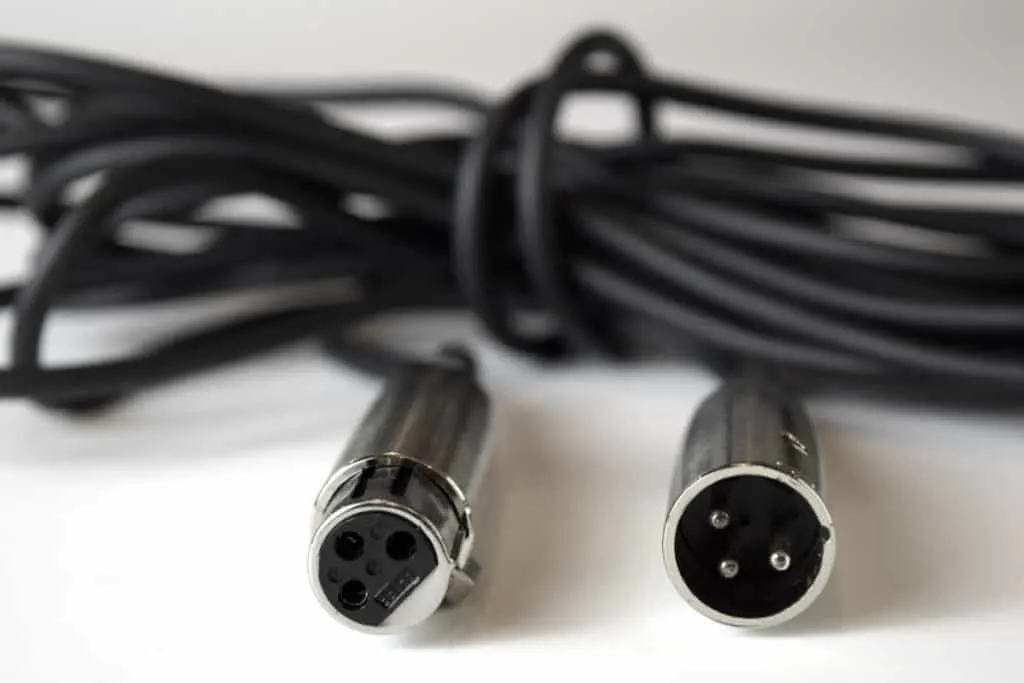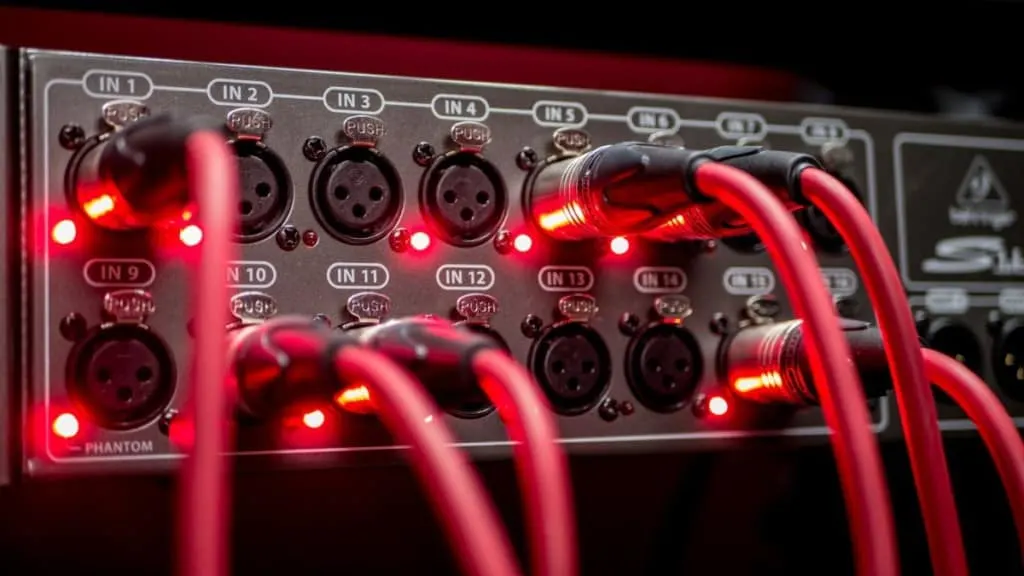XLR cables are vital components in any audio rig where microphones are being used. Whether you’re recording a track into your chosen DAW or sending audio into a mixer for a live performance, you’ll need several XLR cables.
Can XLR cables get wet?
It is not advised to allow XLR cables to get wet, but if they do, they are unlikely to be irreparably damaged. If the cable itself gets wet rather than the connector, this should cause no issues. If the XLR connector gets wet, depending on the extent, it may be rendered useless.
XLR cables are renowned for having two desirable qualities.
Firstly, they are the industry standard for pristine audio quality and carrying balanced signals. Secondly, they are incredibly durable, and this is why they are preferred for live music setups.
Outdoor performances are common, so the XLR cable will inevitably get wet occasionally. In this article, I’ll discuss the situations where they can get wet, and what measures to take to limit the damage.

Wet XLR Cables
Perhaps you’ve been playing an outdoor show, or accidentally left your gear outside when an unexpected rainstorm decided to drench your equipment.
Or, a musician spilled their drink all over your cables onstage. XLR cables are fairly expensive items, so it’s natural that you’d be worried about the damage that getting wet could cause them.
Check out my article that explains why they are expensive here.
The good news is – XLR cables getting wet is a common occurrence.
Ask any live sound engineer and they’re likely to tell you that even when the weather is forecasted to be glorious sunshine, the gods of rock’n’roll like to test them by graying the skies and evoking torrential downpour.
Equipment getting wet is an inevitable part of the job. If musicians and engineers had to replace their XLR cables every time they got wet, the cost would soon add up to an astronomical amount.
Thankfully, XLRs are exceptionally robust cables, and in the majority of cases, they can get wet without being damaged beyond repair.
The durability of XLR cables is a result of the components that are used to construct them.
Manufacturers know that the cables are likely to be subjected to heavy usage, being trampled on tugged, and not being correctly coiled when packed away. Therefore, they build the cables to withstand these rigors, at least to an extent.
I always choose Mogami XLR cables as they are incredibly durable.
Check out Mogami XLR cables here on Amazon
XLR cables consist of five main components. These are:
- Cores (copper conductors)
- PE insulation
- Shield
- Cotton yarn
- Braid
Each of these five components is integral to the audio quality and performance of the cable.
Additionally, they all contribute to its unrivaled durability and form protective layers that can be of aid if the XLR cable gets wet. These five components can be further broken down into three categories which are present on all balanced cables.
Firstly, you have conductors. This includes any internal wires or cores. These internal wires need to be protected from getting wet, as if they do, it could cause irreparable damage.
The role of the conductors is to carry the balanced signal, from a microphone to a mixing desk, for example.
Secondly, there’s shielding.
This is perhaps the most integral part of the cable when it comes to protecting it from damage when it gets wet. The shielding essentially guards the integrity of the audio signal as it passes through the conductors.
Finally, there’s the 3-pin connector which is present on all XLR cables.
- The connectors are the main part of the XLR cable that you should avoid getting wet if possible.
These are the points where the cable links up with other devices and receives power from them.
As we know, water and an electrical current is never a good idea. With that being said, if the connectors do unfortunately get wet, all is not lost. There are ways that we can limit the damage to the XLR cable.
Take a look at this video that shows how to properly clean XLR cables.
What To Do If XLR Cables Get Wet
If you find yourself in a situation when XLR cables have gotten wet, there are some measures you can take to limit the damage and avoid having to replace them.
As we’ve discussed, XLR cables can get wet and still function in most cases, but this depends on the amount of moisture they’ve come into contact with, and for how long.
If only the cable is wet, rather than the connectors, this is much easier to fix. All you need is a dry cloth or towel. Simply lay the cable down uncoiled, and wrap the town around one end. Then, you can slowly pull the cable through the towel, drying the outer layer as you go.
It’s a good idea to stop now and then and move the towel so that you’re using a dry section. Don’t pull the cable too tight, and ensure that it’s not plugged into anything at either end as this will strain it and potentially cause more damage.
If the connector is wet, this is more complicated.
Rest assured, there’s a good chance that you can successfully dry it and restore it to working order again. The best method is to open up the connector. This can easily be done on most XLR cables using a screwdriver.
Then, you can use a hairdryer on a low-heat setting to dry the connector. The slight heat exposure should dry any residual moisture, without getting hot enough to melt or damage one of the mechanisms.
If the water that has gotten onto your XLR cable was not clean, it might be a good idea to first rinse them with clean water, and then repeat the above process to gradually dry them. Dirty water may cause mold if left unchecked, whereas clean water is less likely to degrade the cable and its connector.
The truth of the matter is, XLR cables can get wet without being overly harmed, in the majority of cases. The key here is drying them properly and not allowing the water to sit in the cables.
Sound engineers are bound to experience wet XLR cables on many occasions.
The rain spilled drinks, or muddy footprints are some of the main culprits. When XLR cables get dirty, they have to be cleaned, and I’ve even heard of some sound engineers using hoses to clean their cables before shows!
The water won’t cause lasting damage to the XLR cable, providing it is thoroughly dried before you use it again. Removing the connectors and gently drying with a hairdryer is by far the most effective method to treat a wet XLR cable.
Preventing XLR Cables From Getting Wet
Now that we’ve established that XLR cables can get wet without being irreparably damaged, you might be wondering if there are any ways to further protect the cables and prevent them from getting wet in the first place.
The old saying “prevention is cheaper than the cure” rings true in this instance, and thankfully, there are some tried and trusted methods used by sound engineers and musicians which limit the chance of wet damage occurring to XLRs.
The first option is to customize the XLR cables and use Neutrik connectors.
These connectors are the best on the market in terms of durability, protection, and quality. The only downside is, this is reflected in their hefty price tag.
Using Neutrik connectors is likely to fully prevent water damage, but it requires cable customization and knowledge of how to install the connectors.
Take a look at my article on SpeakOn connectors here.
The second, more accessible option is commonly used by sound engineers at festivals or outdoor music events. This involves the use of silicone tape.
This tape is easy to get hold of, and pretty inexpensive. It is also 100% waterproof and exceptionally durable, which is why it is often used by the military for various applications.
All you need to do is simply wrap the tape tightly around the cable, keeping it narrow and aiming to cover the mating points of the XLR. The tape only sticks to itself, so there’s no danger of it being hard to remove afterward. It will provide the necessary protection to prevent your XLR cables from getting wet.
The table below shows the various methods you can use to protect or repair XLR cables that have gotten wet.
| Method | Pros | Cons |
| Hairdryer | Dries the residual water in connectors | Doesn’t prevent damage |
| Neutrik Connectors | Prevents wet damage from occurring | Expensive requires cable customization |
| Silicone Tape | Easy to apply, protects connectors | Water may still enter the connector |
| Towel-drying | Prevents cables from water damage | Doesn’t prevent damage |
Related Questions
Are all XLR cables balanced?
XLR cables have three-pronged connectors, which makes them capable of carrying a balanced cable. All XLR cables have this capability.
Can you use TRS Jack cables with microphones?
No, it is not advised to use anything other than balanced XLRs for microphones. TRS jack cables are great for line-level devices, like electric guitars, keyboards, or preamps, but not for microphones.
What is direct monitoring?
Direct monitoring is a common feature on audio interfaces. It allows you to hear the sound source that is being recorded in real-time, without setting up playback on your DAW.
I hope this article puts your mind at rest. XLR cables can get wet but it makes some sense to protect them from the elements also.

